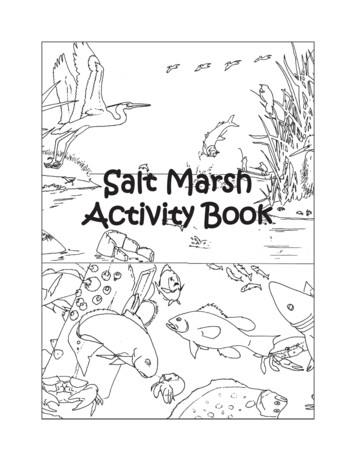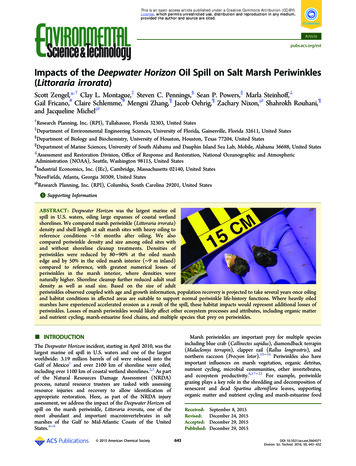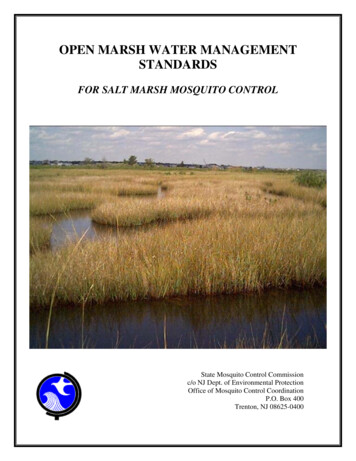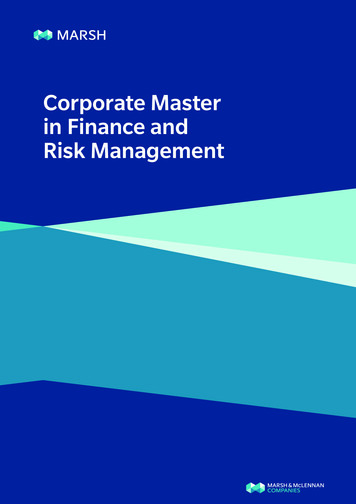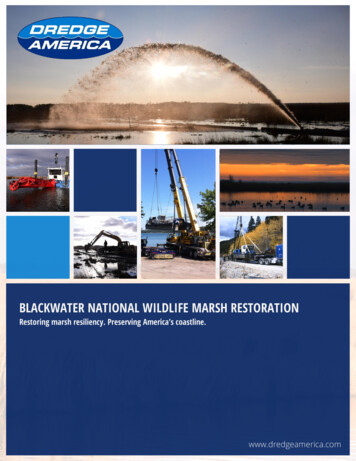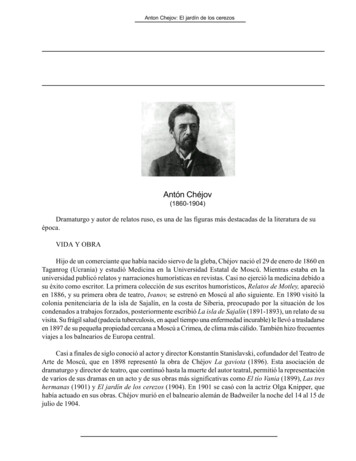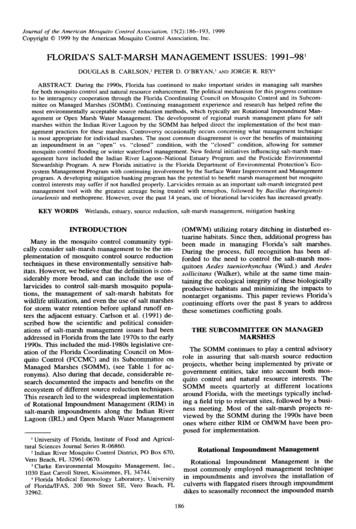
Transcription
Journal of the American Mosquito Control Association, l5(2):186-193, 1999Copyright @ 1999 by the American Mosquito Control Association, Inc.FLORID AfS SALI-MARSH MANAGEMENT ISSUES: 1991-98'DOUGLASB. CARLSON,'PETER D. O'BRYAN,3AND JORGE R. REY4ABSTRACT. During the 1990s, Florida has continued to make important strides in managing salt marshesfor both mosquito control and natural resource enhancement. The political mechanism for this progress continuesto be interagency cooperation through the Florida Coordinating Council on Mosquito Control and its Subcommittee on Managed Marshes (SOMM). Continuing management experience and research has helped refine themost environmentally acceptable source reduction methods, which typically are Rotational Impoundment Management or Open Marsh Water Management. The development of regional marsh management plans for saltmarshes within the Indian River Lagoon by the SOMM has helped direct the implementation of the best management practices for these marshes. Controversy occasionally occurs concerning what management techniqueis most appropriate for individual marshes. The most common disagreement is over the benefits of maintaining"open""closed" condition, with the "closed" condition, allowing for summeran impoundment in anvs.mosquito control flooding or winter waterfowl management. New federal initiatives influencing salt-marsh management have included the Indian River Lagoon-National Estuary Program and the Pesticide EnvironmentalStewardship Program. A new Florida initiative is the Florida Department of Environmental Protection's Ecosystem Management Program with continuing involvement by the Surface Water Improvement and Managementprogram. A developing mitigation banking program has the potential to benefit marsh management but mosquitocontrol interests may suffer if not handled properly. Larvicides remain as an important salt-marsh integrated pestmanagement tool with the greatest ac'xeage being treated with temephos, followed by Bacillus thuringiensisisraelensis and methoprene. However, over the past 14 years, use of biorational larvicides has increased greatly.KEYWORDSWetlands, estuary, source reduction, salt-marsh management, mitigation bankingINTRODUCTIONMany in the mosquito control community typically consider salt-marsh management to be the implementation of mosquito control source reductiontechniques in these environmentally sensitive habitats. However. we believe that the definition is considerably more broad, and can include the use oflarvicides to control salt-marsh mosquito populations, the management of salt-marsh habitats forwildlife utilization, and even the use of salt marshesfor storm water retention before upland runoff enters the adjacent estuary. Cadson et al. (1991) described how the scientific and political considerations of salt-marsh management issues had beenaddressed in Florida from the late 1970s to the earlyl99Os. This included the mid-1980s legislative creation of the Florida Coordinating Council on Mosquito Control (FCCMC) and its Subcommittee onManaged Marshes (SOMM), (see Table 1 for acronyms). Also during that decade, considerable research documented the impacts and benefits on theecosystem of different source reduction techniques.This research led to the widespread implementationof Rotational Impoundment Management (RIM) insalt-marsh impoundments along the Indian RiverLagoon (IRL) and Open Marsh Water Management' University of Florida, Institute of Food and Agricultural Sciences Journal Series R-06860.'Indian River Mosquito Control District, PO Box 670,Vero Beach, FL 3296I-0670.3 Clarke Environmental Mosquito Management, Inc.,1030 East Carroll Street, Kissimmee, FL 34744.a Florida Medical Entomology Laboratory, Universityof Florida./IFAS, 200 gth Street SE, Vero Beach, FL32962.(OMWM) utilizing rotary ditching in disturbed estuarine habitats. Since then, additional progress hasbeen made in managing Florida's salt marshes.During the process, full recognition has been afforded to the need to control the salt-marsh mosquitoes Aedes taeniorhynchus (Wied.) and Aedessollicitans (Walker), while at the same time maintaining the ecological integrity of these biologicallyproductive habitats and minimizing the impacts tonontarget organisms. This paper reviews Florida'scontinuing efforts over the past 8 years to addressthese sometimes conflicting goals.ON MANAGEDTHE SUBCOMMITTEEMARSHESThe SOMM continues to play a central advisoryrole in assuring that salt-marsh source reductionprojects, whether being implemented by private orgovernment entities, take into account both mosquito control and natural resource interests. TheSOMM meets quartefly at different locationsaround Florida, with the meetings typically including a field trip to relevant sites, followed by a business meeting. Most of the salt-marsh projects reviewed by the SOMM during the 1990s have beenones where either RIM or OMWM have been proposed for implementation.RotationalImpoundrnentManagementis theManagementImpoundmentRotationalmost commonly employed management techniquein impoundments and involves the installation ofculverts with flapgated risers though impoundmentdikes to seasonally reconnect the impounded marsh186
FLoRTDASnlr MlnssJuNs SOMMSWIMUSFWSAmerican Mosquito Control AssociationBest Management PracticesComprehensive Conservation and Management PIanU.S. Environmental Protection AgencyEstuarine Wetland Rapid AssessmentProcedureFlorida Coordinating Council on Mosquito ControlFlorida Department of Agriculture andConsumer ServicesFlorida Department of EnvironmentalProtectionFlorida Mosquito Control AssociationIntegrated Pest ManagementIndian River LagoonMerritt Island National Wildlife RefugeNational Estuary ProgramOpen Marsh Water ManagementPesticide Environmental StewardshipProgramPelican Island National Wildlife RefugeRotational Impoundment ManagementSouth Florida Water Management DistrictSt. Johns River Water Management DistrictSubcommittee on Managed MarshesSurface Water Improvement and ManagementU.S. Fish and Wildlife Serviceand estuary. Culverts are closed in the late springand the marsh is minimally flooded by pumpingduring the summer months to prevent ovipositionby salt-marsh mosquitoes. In the early fall, culvertsare opened to the estuary enabling the annual fallhigh tides to enter the marsh. Rotational impoundment management is generally agreed to be the bestcompromise to allow the marsh to function in themost natural way while still allowing source reduction mosquito control with a minimum of pesticideuse (Carlson et. al. 1991). Recent work by Tayloret. al. (1998) has demonstrated a quick response bytransient fish in using culverts to enter and exit apreviously isolated impoundment after it was reconnected to the estuary through culverts.Open MarshWaterManagementDuring the 1990s, OMWM has been increasinglyimplemented in Florida, especially along the northern IRL in Volusia and Brevard counties (Fig. 1).Open marsh water management connects mosquitoproducing areas on the marsh to deeper water habitats, thus facilitating circulation, intemrpting mosquito oviposition and/or allowing larvivorous fishaccess to mosquito larvae (Carlson et al. 1991).Northern IRL OMWM projects have been implemented in breached impoundments, on high marsht87MANAGEMENTislands, and on spoil islands, largely where oldditches were no longer functional (Stewart 1997).Regionalmarsh managementPlansBy the late 1980s it became apparent to somethat we risked managing virtually all marshes alongthe IRL in the same way. Given the fact that mostmarshes have been impacted in one fashion or another, and that reverting to pristine conditions isoften not possible, identical management of allmarshes may not be best; within given geographicareas, some variety was deemed most appropriateBeginning in the early 1990s, the SOMM beganconsidering the move toward block management'This involves the grouping of impoundments andand ecologicallymarshes into geographicallymeaningful management areas and applying different management techniques to various marshes ofeach group.The members of the SOMM believed that without a comprehensive, lagoonwide managementstrategy, block management would not be widelyapplied because impoundment management continued to take place largely on an impoundment byimpoundment basis. As a result, opportunities forimproving environmental conditions in the lagoonare potentially being squandered. Areas are oftennot managed in the best possible way, and manyadjoining areas are managed identically when theremay be a legitimate need for alternative management there.The first attempt to develop a block m:rnagementapproach was for the Sebastian Inlet ManagementArea in northern Indian River and southern Brevardcounties on Florida's central east coast (Fig. 1). Themanagement plan developed for this area encompasses 15 impoundments and advocates a variety ofmanagement strategies for different impoundmentsin the area. Proposed strategies include the use ofRIM in some impoundments, management for wading bird habitat enhancement in others, and leavingsome intertidal all year with the use of ecologicallysound larvicides for mosquito control when needed.The St. Johns River Water Management District(SJRWMD), through the Surface Water Improvement and Management (SWIM) program fundedthe implementation of much of this managementplan with the cooperation of the Indian River andBrevard County Mosquito Control Districts.Given the success of implementing this SebastianInlet plan, in early 1993 the federally funded (National Oceanographic and Atmospheric Administration) Coastal Management Program (administeredin Florida by the Deptartment of Community Affairs) provided funds to continue developing regional marsh m,uragement plans for the remainderof the IRL. The Indian River Lagoon-National Estuary Program (IRL-NEP) and the SJRWMD'sSWIM program later funded completion of thisproject. The ensuing document, entitled Region'al
188Fig. l.JorinNlL or .rHr AvenrcAN MoseunoCotrnolAssoclnrtor.lEast-centralFlorida's Indian River LagoonMarsh Management Strategies for the Indian RiverLagoon (Rey et al., in press), is intended to provideguidance for natural resource managers seeking toimplement best management practices (BMPs) inthe lagoon's marshes. This document also becamean integral part of the IRL-NEP's ComprehensiveConservation and Management Plan (CCMP). TheSOMM meetings provided the forum for discussing, fine-tuning, reviewing, and ultimately adoptingthe resulting plan. In addition to receiving input forthis document at 5 SOMM meetings over a 2-yearperiod, presentations to numerous special interestgroups (e.g., Audubon Society, Friends of the Sebastian River, Native Plant Society, Sierra Club),totaling several hundred individuals, were made tosolicit their input. The document identifies the numerous management options available and discusses the benefits and liabilities of each. The documentalso defines and describes 10 management areasalong the lagoon based upon shared geographicaland ecological characteristics. This includes a discussion of the important attributes within each area(e.g., rookeries, inlets, large seagrass beds). Andfinally, the document develops specific management strategies in the 10 management areas. Thisdocument is serving as a planning tool for thoseinvolved in management of the IRI-ls marshes. Thisdocument is intended to be updated as scientificknowledge, marsh ownership, and conditionschange. However, a document such as this is never
JuNs 1999FlomrnS,qlr Mnnss MnIlecPurNrwithout some controversy. Even though it wasunanimously adopted by the SOMM, concernswere later raised that in some areas, the plans didnot adequately stress opening of impoundments,and placed too much emphasis on specific concernssuch as water quality, mosquito control, waterfowl,endangered species, and storm-water management.However, it is important to point out that an ambitious multidisciplinary effort such as this can notbe carried out in a vacuum, thus geographical andpolitical considerations, as well as existing and projected anthropogenic impacts, must be taken intoaccount in order to maintain momentum in establishment of lasting BMPs for the entire ecosytem.Disagreementsover marsh managementgoalsSince the late 1970s, when mosquito control andenvironmental resource agencies were in seriousdisagreement over how to manage salt-marsh impoundments, SOMM meetings have served as anavenue where these disagreements have been discussed and in many cases, compromises reached.This controversy first manifested itself with mosquito control's need to close and flood impoundments during the summer months. As mentionedabove, RIM and OMWM evolved as the 2 compromise techniques that most marsh managers couldagree upon as viable methods that allowed formany management interests to co-exist. However,as management possibilities have increased, newareas of controversy have occurred, particularly inregard to the management of coastal wetlands foravian habitat enhancement.Waterfowl management: Some controversy hascontinued concerning managing large impoundment acreages for waterfowl at the expense of fisheries, or other management goals that presumablyrequire the maximum interconnectedness of themarsh and estuary. Currently, the most prevalentcontroversy is the desirability of closing and flooding some impoundments during winter to benefitmigratory waterfowl. This winter closure diminishes the period that the marsh can be connected tothe estuary. The vast majority of marsh acreagemanaged for waterfowl in Florida exists on federalwildlife refuges, in particular the Merritt Island National Wildlife Refuge (MINWR) in Titusville (Fig.1), managed by the U.S. Fish and Wildlife Service(USFWS). One of the mandates of the MINWR iswaterfowl management and the USFWS is not likely to abandon this mission, padicularly in view ofthe importance of this area to the migratory patternsof many waterfowl species. Compromise efforts arenow being focused on temporal and spatial alternation of management in different impoundmentsso that in each area of the refuge some connectionto the IRL is always maintained.Wading bird management: Over the past decade,increased interest in managing some impoundedwetlands to enhance habitat quality and feeding op-t89portunities for wading birds has persisted alongeast-central Florida. In Indian River County (Fig.l), impoundment management for wading birds hasbeen accomplished through a cooperative venturewith the USFWS employing a winter floodingspring drawdown strategy that alternates annuallybetween 2 impoundments within the Pelican IslandNational Wildlife Refuge (O'Bryan and Carlson1995). This winter flooding does decrease the period of the year in which an impoundment is connected to the lagoon. However, given the proximityof the Pelican Island rookery to these impoundments and the importance of enhancing avian feeding opportunities in the refuge, wading bird management with the associated winter closure hasbeen deemed appropriate at these impoundments.An interesting complication of this managementpractice has been the fact that elevated fecal coliform levels have occurred in waters adjacent to oneof these impoundments, at the location of a clamaquaculture venture. The contention by the FloridaDepartment of Environmental Protection (FDEP)has been that fecal coliform bacteria generated bythe birds utilizing this impoundment exit the impoundment through nearby culverts and contaminate the clam beds. Although one study did notsubstantiate this claim (O'Bryan and Carlson1997),2 culverts connecting the impoundment andestuary near the clam beds have been closed because of continuing public health concerns. However, to date, the source of the coliform con&lmination has not been determined.In St. Lucie County (Fig. 1), wading bird management has been successfully pursued throughsummer drawdowns of numerous RlM-managedimpoundments on a rotating basis (Swain and Rosier 1992, Sewell etal. 1997). The management goalof providing maximum connection between the impoundment and estuary is considered very consistent with this summer drawdown approach and atthe same time enhances wading bird feeding opportunities. With this management technique, nocontroversy has occurred between those interestedin maximizing the marsh-estua.ry connection andthose interested in improving wading bird habitat.The 2nd and 3rd Workshops on Salt MarshManagement and ResearchDuring the 1990s, SOMM sponsored 2 workshops, the 2nd and 3rd Workshops on Salt MarshManagement and Research, designed to bring interested individuals up-to-date on salt-marsh management activities and salt-marsh-related researchin the state. Abstracts of presentations for the 2ndWorkshop (held in 1992) were published as Bulletin 2 of the Florida Mosquito Control Association(FMCA) (Carlson et al. 1992). Presentation abstracts from the 3rd Workshop (held in 1996) werepublished as FMCA Bulletin 3 (Carlson et al.1997). Both publications provide valuable summa-
190Jounxnr- oF THE AMERIcIN Moseurrories of topics as diverse as the early history of mangrove swamps and salt-marsh management in Florida (Beidler l992,Hafien1997), regulatory agencyperspectives on salt-marsh management (Julianna1992, Tilton 1992), the potential of yan and Carlson 1992, Swain and Rosier1992), artd the effects of predicted sea-level rise onsalt-marsh management (Parkinson et al. 199'7).Internationalpersonnel exchange programTo promote an objective of sharing salt-marshmanagement and research information, the FMCAhas embarked on an International Personnel Exchange Program. Since 1994, several Florida mosquito control offices have participated in a personnel exchange program with Australia. To date, 5Australians and 2 Floridians have made the transPacific trip. Arriving in the host country, selectedparticipants spend 2-3 months in a hands-on program, learning mosquito control techniques used inthe country by actual participation. Also, by stayingwith host families, participants learn the cultural activities of the state and forge long-lasting friendships.Some of the areas in which participants havelearned new ideas and techniques and, in many cases have implemented them in their home country,have dealt with the following issues: larvicide application and calibration techniques, source reduction methods, political and environmental concerns,identifying and monitoring disease-bearing arthropods, and the increasingly difficult task of providing mosquito control to a public that continues tobuild closer and closer to mosquito-producing yetenvironmentally sensitive marshes. The programsof the 2 countries are dissimilar enough to allowlearning of new ideas and techniques, yet the mosquito-producing habitats are similar enough tomake those ideas applicable.FLORIDAWHITE PAPERCONTROLON MOSQUITOAt a meeting of the FCCMC during early 1994,a representative of the u.S. Environmental Protection Agency (EPA) made a request that the Floridamosquito control community develop a white paperto explain its practices. Early discussions stated thata goal of this project should be to identify ways inwhich pesticide use and risk can be reduced in thefuture. This goal of reduced pesticide use and riskis an objective of the EPAs Pesticide Environmental Stewardship Program (PESP) (discussed below),of which the American Mosquito Control Association (AMCA) is a partner and the FMCA is a participant. Each chapter of the Florida White Paperwas individually approved by the FCCMC. TheFlorida White Paper includes several chapters dealing with salt-marsh management issues, stressingCoNrnoL AssocrlrroNVor. 15, No. 2the importance of an integrated pest management(IPM) approach to properly accomplish the saltmarsh management goals of effective, economical,and environmentally compatible mosquito conffolwith a minimum of pesticide use (Florida Coordinating Council on Mosquito Control 1998a). Tobring the development of the White Paper to a conclusion, a conference entitled Urban Growth andits Impact on Future Mosquito Control Problemsand Opportunities was held in May 1998. Thismeeting provided a forum where discussions occurred on many issues, including current issues facing Florida mosquito control, potential future problems and opportunities, and recommendations onhow to solve those issues in the upcoming years.The recommendations, which include salt-marshmanagement issues, were reviewed and adopted bythe FCCMC in August 1998 and have been published, along with abstracts of the speakers presentations, as an addendum to the White Paper (FloridaCoordinating Council on Mosquito Control 1998b).INFLUENCINGFEDERAL INITIATIVESMANAGEMENTSALT.MARSHIndianRiver Lagoon-NationalProgram (IRL-NEP)EstuaryThe National Estuary Program (NEP) was initiated by rhe Water Quality Act of 1987. The NEPidentifies nationally significant estuaries that arethreatened by pollution, development, or overuse,and promotes the preparation of comprehensivemanagement plans to ensure their ecological integrity. The NEP's goals are to protect and improvewater quality and enhance living resources. In1991, the IRL, a 156-mi.-long lagoonal estuaryalong Florida's central-east coast, was designated"estuary of national significance" by the EPAanand the IRL-NEP was established. Over the 5-yearlife of this federally funded program, a CCMP (Indian River Lagoon National Estuary Program,1996) was developed to help achieve NEP goalsalong the IRL. Concerning salt-marsh management,the CCMP identified the goal of restoring impounded marsh functions through implementing RIM orOMWM in isolated marshes. Also identifled in theCCMP was the need to continue the public acquisition of salt marshes to help assure that optimalmanagement techniques can be employed in wetlands that currently are privately owned. Other NEPprograms in Florida during the 1990s included theTampa Bay and Sarasota Bay NEPs. Although neither of the CCMPs developed from these initiativesspecifically addressed salt-marsh management issues relating to mosquito control, the Tampa Bayplan does have salt-marsh management implications by inclusion of the development of a watershed strategy for coastal habitat restoration and protection that will attempt to restore the historic
Jurvr 1999FLoRIDA SeLr Mlnsubalance of key emergent wetland plant commumties (Greening and Lewis 1997).StewardshipPesticide Environmental(PESP)Programln 1994. the EPA. in association with the U.S.Department of Agriculture and the U.S. Food andinitiated a program entitledDrug Administration,PESP The PESP was created because of the nationwide need for an approach to pesticide application that strives to reduce pesticide use and riskwhile considering environmental stewardship. Consequently, environmentally sensitive salt-marshmanagement practices using an IPM approach (e.g.,including source reduction and biorational larvicides) nicely fit the goals of the PESP A key component of the PESP is the development of a publicprivate partnership so when an organization joinsPESP, this partner (e.g., AMCA) must commit tostewardship as a key part of their pest managementpractices. Joining the PESP gives each participantthe opportunity to demonstrate their commitment toenvironmental stewardship and upon joining, eachis assigned a liaison who serves as that group's official EPA contact. An organization desiring to become a PESP partner must develop and implementa strategy document designed to meet PESP goalsby using the safest, most effective, managementpractices available. The AMCA accomplished thiswitl their Partnership Strategy Document where acommitment to an increased dedication to implementing source reduction techniques and the increased use ofbiorational larvicides were the statedsalt-marsh management initiatives to meet PESPgoals (Carlson 1997).The AMCA, through its PESP Working Group,has developed a program whereby organizationsunder the AMCAs umbrella can apply to becomea PESP partner under the AMCAs auspices. In order to achieve this designation, the applicant muststrive to meet the goals and objectives of theAMCAs PESP strategy document, thus an integrated approach to mosquito management must beemployed. Also, the applicant must develop its ownstrategy document, which must provide an overview of their current control practices and defineways in which tlte PESP goals of reduced pesticideuse and risk will be accomplished. Along with several other state mosquito control associations, theFMCA has applied for, and been granted this statusof PESP partner under the AMCAs auspices. TheFMCAsstrategy document has committed theFMCA to continuing to promote the implementation of environmentally acceptable salt-marshsource reduction techniques (e.g., RIM, OMWM)and the use of biorational larvicides in Florida'senvironmentally sensitive wetland habitats IVESMARSH MANAGEMENTSALT.Surface Water Improvement and Management(SWIM) ActA goal of Florida's 1987 SWIM act is to improvethe management of Florida's surface waters. Now,with the termination of state funding for this program, the SWIM program is being supported andadministered by regional water management districts. Along the IRL, the SJRWMD has taken anaggressive role in providing funding to purchaseculverts with water control structures to allow thereconnection of impoundments to the lagoon. Thisis usually entered into as a partnership where theSJRWMD purchases the structures and the localmosquito control agency installs them, managesthem, and maintains them. Since 1991, theSJRWMD has panicipated in the reconnection of4,477 ha of impoundments. The area reconnected,or under contract for reconnection, is approximately 60Vo of the entire IRL impoundment area (approximately 20,000 ha; Brockmeyer et al. 1997).The South Florida Water Management District(SFWMD), which covers the southern portion ofthe IRL, has also provided funds for impoundmentmanagement improvements in St. Lucie and Martincounties.EcosystemmanagementOver the past several years, the FDEP has advocated an ecosystem management approach toFlorida's envfuonmentally sensitive habitats, an approach consistent with current salt-marsh management trends. The ecosystem management goals include improved stewardship of Florida's environment, the development of an environmental ethicand sustainable lifestyle zrmong Floridians, and asustainable, healthy environment and economy. Thecornerstones of the program are place-based management (i.e., flexible management strategies, integrating management tools, creating grassrootssupport), cultural change (i.e., proactive responsesto pollution prevention), common-sense regulation(i.e., flexible consensus-based problem solving),and improved foundations (i.e., developing a statewide resource atlas). The FDEP acknowledges thatsalt-marsh management is important within theirecosystem management initiative and that ecosystem benefits can be achieved by properly designedand implemented salt-marsh projects that includethe input of numerous interested parties (Bess1997).Public acquisitionof salt marshesAlmost a decade ago, Carlson et al. (1991) explained the importance of having salt marshes inpublic ownership in order to allow the implementation of optimal management practices and this
r92JounNel or rns AugntclN Mosquno CoNrnol AssoctnrroNneed remains true today. Although during the1990s, many Florida counties, in collaboration withthe state and regional water management districts,purchased numerous sizable tracts of coastal wetlands, vast areas still remain in private ownership.To correct this problem along the IRL, a proposalnamed the Indian River Lagoon Blueway has beensubmitted to the State's Conservation and Recreational Lands Program. This proposal, wfrich includes the coordinated efforts more than 12 agencies, seeks to purchase approximately 3,300 ha ofwetlands, shoreline uplands, and impounded marshes, all property deemed necessary to maintain thefunctional integrity of the IRL. If placed under public ownership, this land could be more appropriately managed than is now allowed by the current private owners and would significantly benefitsalt-marsh management efforts along east-centralFlorida.MITIGATIONBANKINGOne topic that has the potential to significantlyimpact salt-marsh management and mosquito control in Florida is mitigation banking. Mitigationbanking is a concept by which a person or firm canmake environmental improvements to their property now, be awarded credits for those improvements, and then use or sell those credits, either nowor in the future, to anyone (e.g., developer, governmental agency) who needs to mitigate for some environmental impacts elsewhere, and for which theydo not have mitigation possibilities of their own.Mitigation banking was developed because over thepast 20 years or so, on-site mitigation projects havefrequently been small, disjointed projects that frequently did not provide significant ecosystem benefits. Also, many of these projects were not deemedecologically successful. The figures of the FDEPdemonstrate that in 1990, of the permitted mitigation for wetlands losses, an estimated 34Vo wasnever constructed, although the associated wetlandlosses occurred. Of those projects that were constructed, only l2V" for freshwater wetlands and45Vo for saltwater wetlands sites were successful.Mitigation banking has the potential to minimizemitigation failures and provide ecological benefitsthat were not being met by traditional mitigation(Ertman 1997). Only after the project has beendeemed a success, will the full complement of credits be awarded to the initiator of the project (i.e.,the mitigation banker).The pre- and postbank assessment procedure wi
'Indian River Mosquito Control District, PO Box 670, Vero Beach, FL 3296I-0670. 3 Clarke Environmental Mosquito Management, Inc., 1030 East Carroll Street, Kissimmee, FL 34744. a Florida Medical Entomology Laboratory, University of Florida./IFAS, 200 gth Street SE, Vero Beach, FL 32962.
